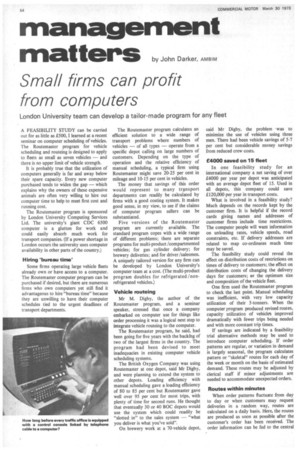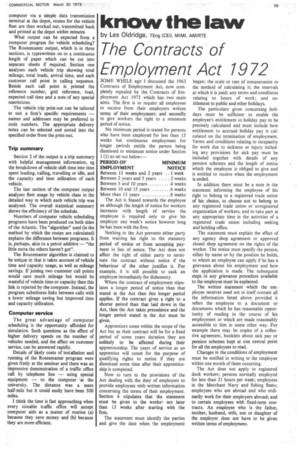management
Page 54

Page 55

If you've noticed an error in this article please click here to report it so we can fix it.
matters by John Darker AMBIM
Small firms can profit from computers
London University team can develop a tailor-made program for any fleet A FEASIBILITY STUDY can be carried out for as little as £500, I learned at a recent seminar on computer scheduling of vehicles. The Routemaster program for vehicle scheduling and routeing is designed to apply to fleets as small as seven vehicles — and there is no upper limit of vehicle strength.
It is probably true that the utilization of computers generally is far and away below their spare capacity. Every new computer purchased tends to widen the gap — which explains why the owners of these expensive animals are often very willing to hire out computer time to help to meet first cost and running cost.
The Routemaster program is sponsored by London University Computing Services Ltd. The university's giant CDC 6500 computer is a glutton for work and could easily absorb much work for transport companies. (If a power shortage in London occurs the university uses computer availability in other parts of the country.) Hiring 'bureau time' Some firms operating large vehicle fleets already own or have access to a computer. The Routemaster computer program can be purchased if desired, but there are numerous firms who own computers yet still find it advantageous to hire "bureau time" because they are unwilling to have their computer schedules tied to the urgent deadlines of transport departments. The Routemaster program calculates an efficient solution to a wide range of transport problems where numbers of vehicles — of all types — operate from a specific depot calling on large numbers of customers. Depending on the type of operation and the relative efficiency of manual scheduling, a typical firm using Routemaster might save 20-25 per cent in mileage and 10-15 per cent in vehicles.
The money that savings of this order would represent to many transport departments can readily be calculated by firms with a good costing system. It makes good sense, in my view, to see if the claims of computer program sellers can be substantiated.
Five versions of the Routemaster program are currently available. The standard program copes with a wide range of different problems; there are separate programs for multi-product /compartmented vehicles; for gas cylinder delivery; for brewery deliveries; and for driver/salesmen. A uniquely tailored version for any firm can be developed by London University's computer team at a cost. (The multi-product program doubles for refrigerated /nonrefrigerated vehicles.) Vehicle routeing Mr M. Digby, the author of the Routemaster program, and a seminar speaker, stressed that once a company embarked on computer use for things like order processing it was a logical next step to integrate vehicle routeing to the computer.
The Routemaster program, he said, had been going for five years with the backing of two of the largest firms in the country. The program had been devised to meet inadequacies in existing computer vehicle scheduling systems.
The British Oxygen Company was using Routemaster at one depot, said Mr Digby, and were planning to extend the system to other depots. Loading efficiency with manual scheduling gave a loading efficiency of 80 to 85 per cent but Routemaster gave well over 95 per cent for most trips, with plenty of time for second runs. He thought that eventually 30 or 40 BOC depots would use the system which could readily be "slotted in" to the sales system — "what you deliver is what you've sold".
On brewery work at a 70-vehicle depot, said Mr Digby, the problem was to minimize the use of vehicles using three men. There had been vehicle savings of 5-7 per cent but considerable money savings from reduced crew costs.
E4000 saved on 15 fleet
In one feasibility study for an international company a net saving of over £4000 per year per depot was anticipated with an average depot fleet of 15. Used in all depots, this company could save £120,000 per year in transport costs.
What is involved in a feasibility study? Much depends on the records kept by the customer firm. It is helpful if the record cards giving names and addresses of customer firms include time restrictions. The computer people will want information on unloading rates, vehicle speeds, road constraints, etc. If delivery addresses are related to map co-ordinates much time may be saved.
The feasibility study could reveal the effect on distribution costs of restrictions on times of delivery to customers; the effect on distribution costs of changing the delivery days for customers; or the optimum size and composition of the vehicle fleet.
One firm used the Routemaster program to check the last point. Manual scheduling was inefficient, with very low capacity utilization of their 5-tonners. When the computer program produced revised routes, capacity utilization of vehicles improved dramatically with fewer trips being needed and with more constant trip times.
If savings are indicated by a feasibility trial alternative methods may be used to introduce computer scheduling. If order patterns are regular, or variation in demand is largely seasonal, the program calculates pattern or "skeletal" routes for each day of the week or month on the basis of estimated demand. These routes may be adjusted by clerical staff if minor adjustments are needed to accommodate unexpected orders.
Routes within minutes When order patterns fluctuate from day to day or when customers may request deliveries in a random way, routes are calculated on a daily basis. Here, the routes are produced as soon as possible after the customer's order has been received. The order information can be fed to the central
computer via a simple data transmission terminal at the depot, routes for the vehicle fleet are then worked out, transmitted back and printed at the depot within minutes.
What output can be expected from a computer program for vehicle scheduling? The Routemaster output, which is in three sections, is typrewritten on to a continuous length of paper which can be cut into separate sheets if required. Section one analyses each vehicle trip showing total mileage, total loads, arrival time, and each customer call point in calling sequence. Beside each call point is printed the• reference number, grid reference, load, expected call time and a note of any special restrictions.
The vehicle trip print-out can be tailored to suit a firm's specific requirements — names and addresses may be preferred to code numbers. The appropriate delivery notes can be selected and sorted into the specified order from the print-out.
Trip summary
Section 2 of the output is a trip summary with helpful management information, eg the breakdown of vehicle shift time into time spent loading, calling, travelling or idle, and the capacity and time utilization of each vehicle.
The last section of the computer output analyses fleet usage by vehicle class in the detailed way in which each vehicle trip was analysed. The overall statistical summary shows the efficiency of the schedule.
Numbers of computer vehicle scheduling programs have been produced on both sides of the Atlantic. The "algorithm" used (ie the method by which the routes are calculated) explains the difference between programs. It is, perhaps, akin to a petrol additive -"the little extra the others haven't got".
The Routemaster algorithm is claimed to be unique in that it takes account of vehicle time and capacity usage, as well as mileage savings. If joining two customer call points would save much mileage but would be wasteful of vehicle time or capacity then this link is rejected by the computer. Instead, the program substitutes links between calls with a lower mileage saving but improved time and capacity utilization.
Computer service
The great advantage of computer scheduling is the opportunity afforded for simulation. Such questions as the effect of higher delivery speeds on the number of vehicles needed, and the effect on customer service, can be answered rapidly.
Details of likely costs of installation and running of the Routemaster program were given freely at the seminar and there was an impressive demonstration of a traffic office call by telephone line — using special equipment — to the computer at the university. The distance was a mere half-mile but it could easily have been 500 miles.
I think the time is fast approaching when every sizeable traffic office will accept computer aids as a matter of routine (a) because they save money and (b) because they are more efficient.










































































































